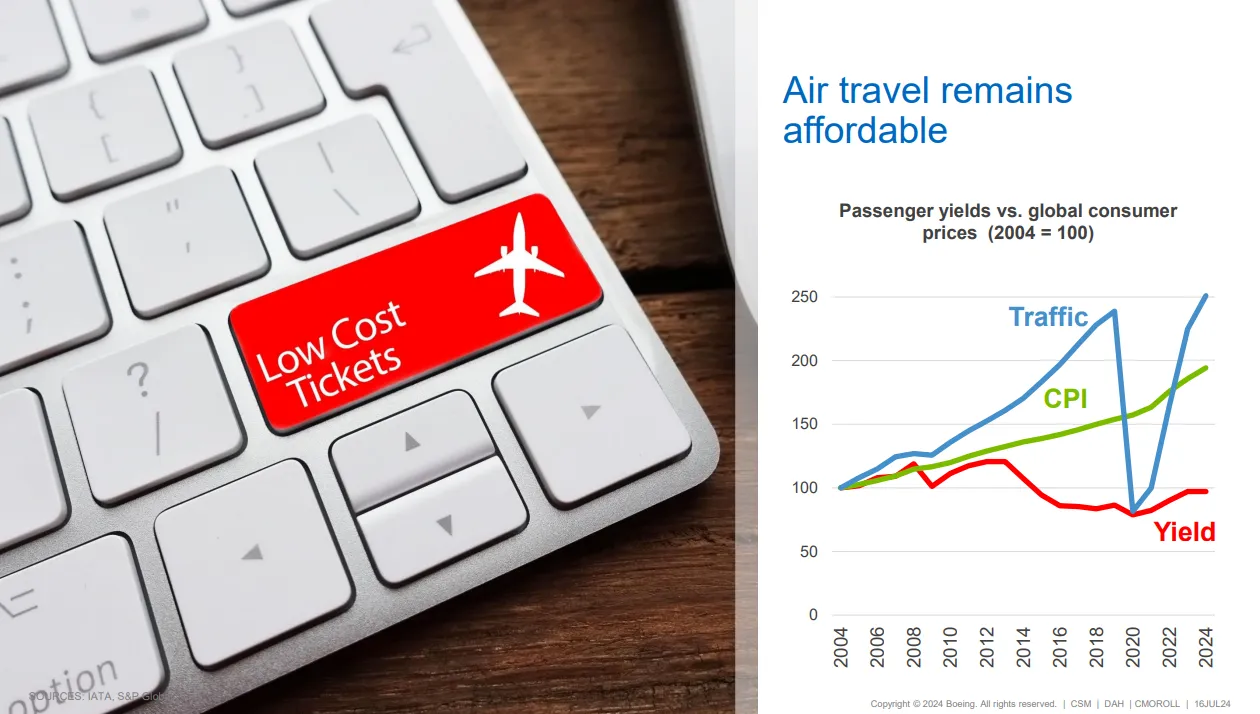
Boeing Forecasts 44,000 New Aircraft Through 2043
Jul 19, 2024

Boeing anticipates a significant demand for new aircraft over the next two decades, projecting the need for approximately 44,000 new planes by 2043. This forecast is driven by factors such as increasing air travel, fleet modernization, and the rise of low-cost carriers. Boeing highlights that the commercial aviation sector will require more efficient and environmentally friendly aircraft to meet growing passenger and cargo needs. The report emphasizes the importance of sustainable aviation solutions as airlines aim to reduce their carbon footprints while responding to the evolving market dynamics and passenger preferences.
Boeing's latest forecast indicates a significant demand for new aircraft in the coming decades, projecting a total of "44,000 new aircraft" required by 2043. This demand is driven by various factors, including rising air travel, fleet modernization, and the need for more environmentally sustainable aviation options. As the aviation industry continues to recover from the impact of the global pandemic, airlines are increasingly looking to expand their fleets to meet the growing passenger demand.
Key Drivers of Aircraft Demand
Several factors are contributing to the surging demand for new aircraft. The primary drivers include:
- Rising Global Air Travel: As economies grow, more people are traveling by air, leading to increased demand for additional aircraft.
- Fleet Modernization: Airlines are seeking to upgrade their fleets to improve fuel efficiency and reduce operational costs.
- Sustainability Goals: With a growing emphasis on reducing carbon emissions, airlines are investing in newer, more environmentally friendly aircraft.
Aircraft Market Segmentation
Boeing's forecast segments the anticipated demand into various categories, highlighting the types of aircraft that will be most sought after. The following table summarizes the projected demand by aircraft category:
| Aircraft Category | Projected Deliveries |
|---|---|
| Narrow-body Aircraft | 30,000 |
| Wide-body Aircraft | 11,000 |
| Regional Jets | 3,000 |
This segmentation underscores the need for "narrow-body aircraft", which are expected to make up the vast majority of new deliveries. These aircraft are essential for domestic and short-haul international flights, catering to the growing demand for air travel in regional markets.
Environmental Sustainability in Aviation
As the aviation industry faces increasing scrutiny regarding its environmental impact, Boeing is committed to developing "sustainable aviation solutions". The company is investing in research and development to produce aircraft that utilize "sustainable aviation fuels (SAF)" and feature advanced technologies to minimize emissions.
In the coming years, airlines will increasingly prioritize fleets that align with global sustainability goals, prompting a shift towards "eco-friendly aircraft". This trend is reflected in Boeing's forecast, emphasizing the importance of sustainability in future aircraft production.
Implications for Airlines and the Aviation Industry
The projected demand for 44,000 new aircraft has significant implications for airlines and the broader aviation industry. As airlines prepare to expand their fleets, they must consider several important factors:
- Investment in New Technology: Airlines will need to allocate resources for acquiring new aircraft that meet modern standards of efficiency and sustainability.
- Operational Adjustments: The introduction of new aircraft models may require changes in training, maintenance, and operational processes.
- Market Competition: Airlines that invest in newer, more efficient aircraft may gain a competitive advantage over those that do not.
Global Economic Factors
The demand for new aircraft is also influenced by global economic conditions. Economic growth in emerging markets, particularly in Asia and Africa, is expected to drive air travel demand. Airlines in these regions are likely to invest heavily in expanding their fleets as disposable incomes rise and more people seek air travel opportunities.
Additionally, the recovery of business travel post-pandemic will play a crucial role in shaping the demand for new aircraft. As companies resume travel plans, the need for efficient and reliable air service will increase, further boosting the demand for new aircraft.
Conclusion
Boeing's forecast of 44,000 new aircraft through 2043 highlights a dynamic and evolving aviation market poised for significant growth. As airlines navigate the challenges of modernization, sustainability, and economic recovery, the demand for new aircraft will remain a critical factor in shaping the future of air travel. With environmental considerations at the forefront, the aviation industry is set to embrace innovation and transformation, ensuring a sustainable and efficient future for air travel.
Overall, the projected demand for new aircraft presents both opportunities and challenges for the aviation industry. By understanding the key drivers of this demand and adapting to the changing landscape, airlines can position themselves for success in an increasingly competitive market.
Related Articles

Explore Thailand: The Best Islands to Visit for Paradise, Adventure, and Relaxation

The Ultimate Guide to the Best Islands in Thailand for Your Next Getaway

Do babies need passports? How to get a passport for a newborn

How to get a U.S. passport fast: here’s how to expedite the process

What is Mobile Passport Control: 5 reasons why you should use it

SENTRI vs. Global Entry: A detailed guide

Do you need a passport to go to the Bahamas? Let’s find out

Do you need a passport to go to Mexico? A detailed guide

Do you need a passport to go to Canada? We got the answer

Do You Need a Passport for a Cruise: An Essential Travel Guide

Booster Seat Requirements: All the Rules to Follow in Your Rental Car

What Are the World’s Most Powerful Passports, and How Does Yours Rank?

How to Take a Passport Photo at Home: A Helpful Guide

You've got to have heart! Southwest's new livery

Your opinion: Should water be free on low cost carriers?

Young women bolder than guys as solo travellers
